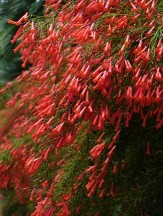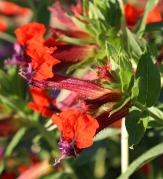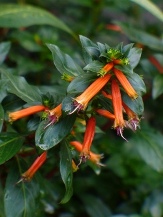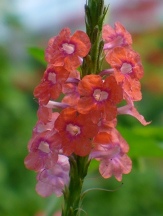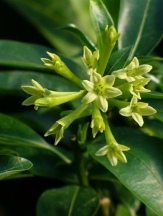How to Plant, Grow, Prune, and Fertilize Hardy Hibiscus (a.k.a. Perennial Hibiscus) including the Confederate Rose
.JPG)
Lord Baltimore Perennial or Hardy Hibiscus
.JPG)
Double White Confederate Rose Mallow,
Hibiscus mutabilis 'Tri-Color'
Few plants can produce the summer long show of huge showy flowers of the Hardy Hibiscus or Perennial Hibiscus. These are also known as 'Dinner Plate Hibiscus' and for good reason as the flowers can be 12-14" across although 8-10" wide is more common. Unless you are working with a true species like unadulterated Hibiscus moscheutos or Hibiscus coccineus, most of the Hardy Hibiscus in the trade today are hybrids derived from crosses including but not limited to the aforementioned species as well as our other native species like H. grandiflorus, H. lasiocarpus, and H. laevis, unlikely but possibly also H. dasycalyx even though most are listed as Hibiscus moscheutos cultivars. Some of the very newest cultivars may include other non-native species in their parentage like in the breeding work conducted by Texas A&M and the Summer Spice series where they are trying to develop true purple, blue, and even orange colored flowers. Some of the newer hybrids with deeply colored maroon to near black foliage add additional color and contrast in the garden and landscape and readily pair with chartreuse colored plants like Maui Gold Elephant Ears. As you will see these hardy Hibiscus make easy, long-lived, and low maintenance additions to the landscape and only get better with age.
As their native habitat and their common names like Swamp Mallow or Marsh Mallow suggest, Hardy Hibiscus originate from wet to consistently moist soils and they enjoy the same conditions in a garden setting. They can also readily be added to bog gardens, moist ditches, can be grown as container plants in water gardens usually with the soil surface near the water's surface, and they can also withstand areas that are periodically flooded. Hardy Hibiscus can be grown in average moist soils with a good deep organic mulch but may need additional moisture during dryer periods. This does not include the Confederate Roses and similar selections like the Single Red or Terri's Pink Confederate Rose and our own introduction Almost Eden's Baby Pink Hibiscus as these prefer average moist, average to well-drained soils and we'll get to these near the lower half of this growing guide.
In order to produce the summer long display of massive dinner plate sized flowers, all of these Hibiscus need ample nutrients to work with. Top dressing with a generous dose of a balanced slow-release non-burning fertilizer, like Scotts Osmocote 14-14-14, in spring just before or once the new stems emerge (about mid- to late March here in zone 8B), again in early June, and one more time in early to mid-August should help to keep your Hibiscus flowering until fall. When you do fertilize be sure apply it evenly over the outer 2/3's of the root zone. Usually starting about 1' away from the center of the plant and working out to about 3' away from the crown of mature plants. Potted plants can just be top dressed with a couple of tablespoons of fertilizer. When you are done just water it in and you are finished. The advantage to a slow release fertilizer is that every time you water or every time it rains your Hibiscus are getting fed.
In the coldest portions of their hardiness range, these perennial Hibiscus are not cued to emerge until soil temperatures have sufficiently warmed and the days are sufficiently long. I think of these as tropical plants that have adapted to hide/hibernate underground to overcome the freezing temperatures of winter. Most are smart enough, though we might think them slow, to wait until after all danger of frost and freeze have passed before emerging in spring. My grandfather would use the Pecans as a guide for when we were at the last frost date but these Hardy Hibiscus are even later at emerging. Be patient as it can be May in some areas before you begin to see signs of life.
All of these perennial Hibiscus, including the Confederate Roses, prefer a full to mostly sunny site in the garden and landscape. More sun generally equates to more and larger flowers and deeper foliage colors for those that have dark foliage. A minimum of 6 hours a day of direct sunlight is required for strong sturdy stems and flowering while 8 or more is optimum.
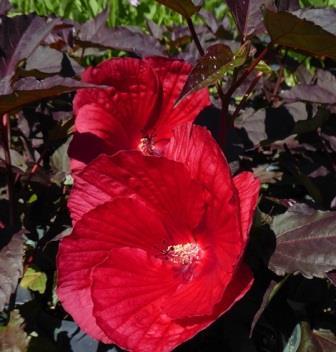
Mimi Perennial or Hardy Hibiscus
There is one more maintenance step for growing these hardy Hibiscus - pruning. Try to leave the dead brown stems over winter or just cut them back to a foot or so high as these spent stems will still provide some protection for the crown of the plant, especially at the upper limits of their cold hardiness zone. An insulative but breathable organic mulch, like pine straw or pine bark, can also help to protect the crown and dormant buds and may provide as much as half a zone of winter hardiness. Once you see signs of new stems growing in mid to late spring, you can go ahead and cut out the old dead stems from last winter leaving them about 4-12" high. Confederate Roses may not freeze all the way back, or even at all, in the mildest winter climates (zone 9 in mild winters and zone 10,11) and may flower even flower again in spring. If the Confederate Roses have some freeze damage you can just cut them back to healthy living wood (You should see a green ring of cambium all the way around the stem when you cut it back. You probably will not see this green ring of cambium on the Hardy or Perennial Hibiscus when you cut them back). Young new plants can be pinched or tipped when they reach about 6-8" high to help them branch out and be fuller though it may set flowering back by a couple of weeks. If you prune your Confederate Roses in late summer you could be removing flower buds so try to get any additional pruning done before the end of June if possible.
Growing Confederate Roses
.JPG)
Almost Eden's Baby Pink Perennial Hibiscus
The true Condederate Rose, Hibiscus mutabilis and its cultivars, are mid-day length flowering species producing loads of huge typically very double 4-6” wide flowers in late summer and fall over an extended period. This is a large growing Hibiscus that can ultimately reach 10-20’ high and wide so be sure to give it plenty of room in the landscape. Confederate Roses, as well as the non-daylength specific (which means that they flower from late spring to fall, not just fall and/or spring) typically smaller growing Almost Eden's Baby Pink Perennial Hibiscus and Terri's Pink Perennial Hibiscus (it was sold as the Single Red Confederate Rose, Hibiscus mutabilis 'Rubrum' for many years) prefer an average moist, average to well-drained, fertile soil in a full to mostly sunny position in the garden and landscape for optimum health, vigor, and flowering. These old pass-a-longs are generally resistant to short periods of drought once well-established.
Even those these are perennial plants, they are what I call true die-back perennials. These are tropical plants that can survive as long as their crown is left safely intact. In other words the stems of the plants actually physically freeze and die back to near or to the actual crown of the plant at the soil line. In zones 8 and colder a breathable, insulative winter mulch around the crown of the plant is typically required to help protect the tender growing points that these plants will emerge from in spring. Plant these truly tropical Hibiscus as early in the spring (once all danger of freeze and frosts have passed) and summer as possible so that they will have all summer to get well-established so that they will be strong enough to survive the upcoming winter. Any of the reliably hardy Hardy or Perennial Hibiscus (Hibiscus moscheutos types) can be planted year round including while winter dormant but should be given a mulch to help ensure thier survival.
If you are overwintering the Confederate Roses, Baby Pink, or Terri's Pink Hibiscus indoors provide as much direct sunlight as possible and provide a location where temperatures remain above freezing and preferably above 50-55oF. Containerized plants can normally easily withstand short dips below 32oF but extended periods (hours) below 32oF may allow the soil and thus the tender crown of the plants to freeze ultimately killing them.
For general planting and initial watering instructions please see our Planting a New Plant… Growing Guide available on our website under our Information Menu ( On PC it is at the lower left side of any webpage and located just below our plant Categories. On mobile the Information Menu is near the bottom of any of our website's pages). You can also find this growing guide near the bottom of any individual plant product page.
.JPG)
Hibiscus Sawfly Larva on Hibiscus Leaf (Click here for a full size image)
Keep an eye out for pests such as white flies, Hibiscus sawflies (learn more about these in the next paragraph), spidermites, mealy bugs, and other soft scales but outdoors under good conditions these pests are generally kept in check by natural predators.
Hibiscus Sawfly larva can make your Hardy Hibiscus and Turkscaps look pretty unsightly by skeletonizing (eating the material between the veins of the leaves and can create a lacy look) their foliage. The larva look for all the world like small green and yellow caterpillars and they tend to be gregarious when young feeding in large groups for protection. Once they are large enough to pupate they create a whitish foam-like cocoon along the stems, at the base of the plants, and in the soil around the plants. Adults are small solid black flies with an orange exposed thorax just behind the head. If you only have a few Hibiscus plants manual removal may be enough to control them. You can pick off and squish the cocoons, individual larva, or cut off entire leaves and drop them in a solution of soapy water. Almost any broad spectrum insecticide that works on soft bodied insects, like aphids, should be effective such as insecticidal soaps, horticultural oils (not dormant oil), and products containing spinosad. Always read and follow the label and apply it as per the instructions.
Excellent Online Resources on Growing Hardy Hibiscus
How About A Hardy Hibiscus by Dan Gill, LSU Agcenter Horticulturist
http://apps.lsuagcenter.com/news_archive/2014/may/get-it-growing/How-about-a-hardy-hibiscus-.htm
Growing Tropical and Hardy Hibiscus from the University of Missouri Extension
http://extension.missouri.edu/adair/hibiscus.aspx
Hibiscus from the Clemson Cooperative Extension Home & Garden Information Center
https://hgic.clemson.edu/factsheet/hibiscus/
Hardy Hibiscus from Texas A&M AgriLife Extension – East Texas Gardening
https://easttexasgardening.tamu.edu/2014/06/28/hardy-hibiscus-2/
Growing Hardy Hibiscus from the K-State Research and Extension Service – Johnson County
https://www.johnson.k-state.edu/lawn-garden/agent-articles/perennials/growing-hardy-hibiscus.html
Hardy Hibiscus from the Mississippi State University Extension – Back to Southern Gardening
https://extension.msstate.edu/southern-gardening/video/2014/hardy-hibiscus
We hope this helps to get your perennial Hibiscus growing and flowering to their full potential! Please feel free to contact us if you have any additional questions, comments, or input.
Thank You & Good Growing,
Jeff McMillian
& the Crew at Almost Eden
![]()

